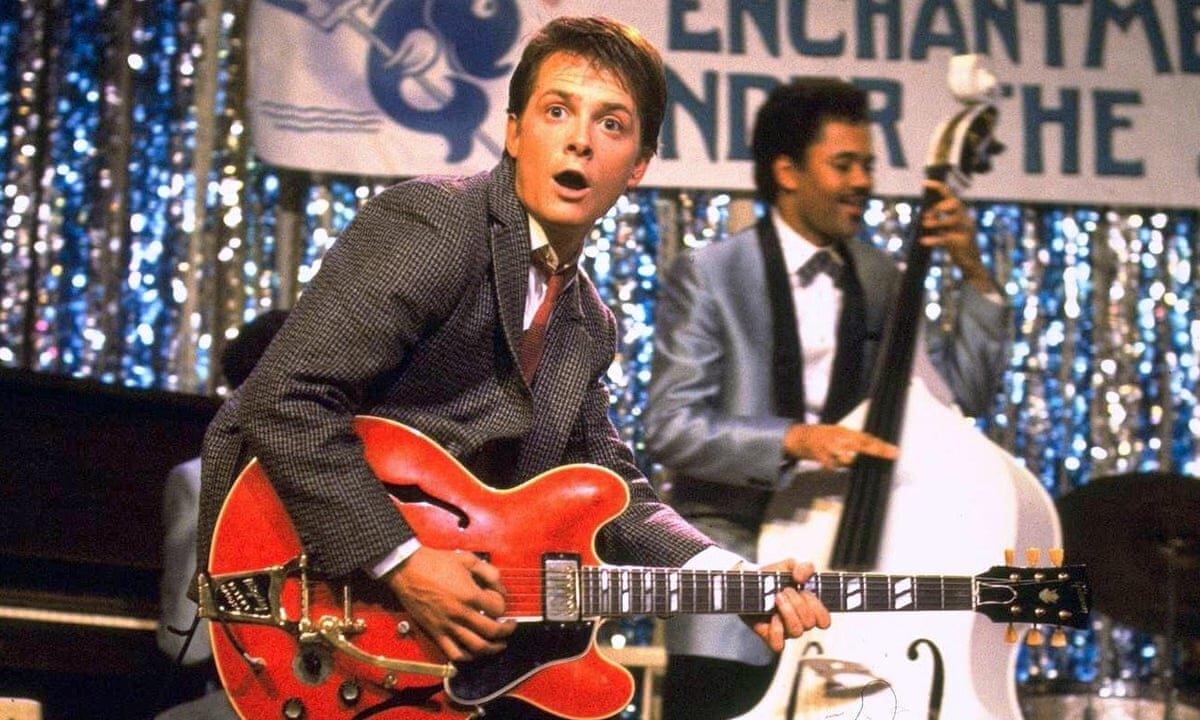3 Musical Inaccuracies In Back To The Future
By: Ivan Munoz
Ah, Back To The Future, a timeless classic, and a personal favorite of mine. What’s better than an unassuming underdog beating the odds against a bully and winning out in the end? Right- one that does that, WHILE TRAVELING THROUGH TIME. Well what’s better than that? Of course, one that also plays guitar!
As a gear lover and vintage musical instrument enthusiast, I’m always keeping my eyes peeled for any piece of gear on TV and in movies; I take great joy in investigating whether a piece of musical gear is period correct to the movie.
I can imagine that, as a set designer who needs to be an expert in everything, it’s incredibly difficult and taxing to get every last exacting detail right- especially for something 90% of people would never notice nor care about. Well, as one of the 10% I can honestly tell you that we don’t really care. Part of enjoying any fiction film is the suspension of disbelief; if I can entertain the idea of modified, flying, and time traveling DeLoreans, I can sure as hell consider the idea that the universe in the movie isn’t the same as our own.
However, all this being said, its always fun to nitpick and see all the tiny details that slip through the cracks.
The particular scene I’m referring to is the highschool dance where Marty McFly triumphantly picks up the guitar, plays a raucous rendition of Johnny B. Goode with an amazingly ahead of it’s time guitar solo in the style of Eddie Van Halen, and then utters the now famous line “I guess you guys aren’t ready for that yet, but you’re kids are gonna love it!” So let’s say this took place in early June of 1955. Here are three historical inaccuracies that are impossible to “un-see.” See it here in the video below:
1. The Guitar
The most iconic part of this scene is that beautiful red guitar. Everything about it from Gibson’s design to the ornate gold hardware and pearl inlays screams elegance and exuberance; while somehow still maintaining class and grace. Fun fact: believe it or not, this is the scene that made John Mayer decide he wanted to be a guitarist, but I digress. The exact model of this guitar is a Gibson ES-345. Featuring semi-hollow construction, it has a “variatone” switch and stereo wiring, which allows for a wide pallet of sounds, two now famous “patent applied for” humbuckers, and is equipped with a Bigsby B7 vibrato. But however pretty in sound and in looks, this guitar that rings like a bell, simply wasn’t around in 1955. The ES-345 was first seen in 1959 after it was released as another model to Gibsons electric line. Based on certain distinguishable features of this guitar, such as the gold ring around the variatone switch and the short pickguard, this guitar is, at the earliest, a 1961 model.
2. The Distortion
In this scene our beloved protagonist is able to get some killer tones, distortion included. And while it was theoretically possible to distort a signal in 1955, the degree to which and technique with which it was distorted is not period correct. In 1955, amps had yet to be given a ‘volume’ and ‘master volume’. They only had a ‘volume’ knob. When ‘master volume’ was incorporated, the ‘volume’ was able to essentially control the gain. But as of 1955, the feature had not been invented.
Therefore, in order to achieve these tones, Marty would have had to turn the amplifier all the way up and get pretty close to it with the guitar to get it to feed back properly. We can see that between the first song, Earth Angel, and the second number, Johnny B. Goode, Marty does not touch the amp one bit. Now based on the sound and the tone of the guitar during Earth Angel, it is certain that amp’s volume was not maxed. Therefore, he would not have been able to the get that sound.
NOTE: The first true documented use of distortion as a purposeful concept is largely thought to be 1951’s ‘Rocket 88’ by Jackie Brenston’s Delta Cats…none the less; its not quite the same as the fairly Van Halen-esque distortion featured here.
3.The Spring Reverb
Another feature of the amp that was not yet present in 1955 is the spring reverb. At minute marker 5:12 in the video above you can hear the distinct sound of a spring reverb unit going haywire when Marty kicks over the amp in a rock and roll induced fit of passion. However, spring reverb was not used in a guitar amp until around 1963. In the meantime, if anyone knows which exact amp was the very first, feel free to write in drop us a line.
And hey, is it really all that unrealistic to consider that, off camera, Marty stopped off at a pawn shop in 1965 along the way to grab a couple used instruments for his new friends? I know I sure would.
If you like this content, support Victor by visiting VictorRecords.com and signing up to our mailing list today! Join our historic movement for the future in taking back the music industry.
About The Author
Ivan Munoz is a musician, bassist, singer, musicians advocate, and member of the Victor Talking Machine Company. Along with this Ivan can be found devoting his time to various musical projects, compositions, and working on musical instruments. Click the photo for more!





